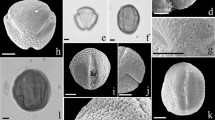Abstract
Tribe Stewartieae (Theaceae) consists of evergreen Hartia and deciduous Stewartia. Pollen morphology was investigated using light and scanning electron microscopy in 6 species of Hartia and 11 species of Stewartia. Hartia has a reticulate or microreticulate pollen sculpture pattern, a psilate or foveolate margo and a round or acuminate colpus tip, and no operculum. On the other hand, Stewartia (Old World species) has pollen with a rugulomicroreticulate sculpture pattern, a constrictive rugulomicroreticulate margo, an acuminate colpus tip, and a distinct or obscure operculum. Two New World species of Stewartia, however, exhibit pollen with some Hartia characteristics (e.g., reticulate or microreticulate surface in S. malacodendron, round colpus tip in S. ovata, and no operculum in either species). Thus, two New World species have mixed pollen characteristics between Old World Stewartia and Hartia species. We argue that several significant differences in pollen characteristics between the two genera warrant the recognition of two distinct genera rather than one broadly defined genus. We found that the tribe Stewartieae, based on pollen morphology, can be divided into three groups, Hartia, Old World Stewartia, and New World Stewartia. Additional detailed phylogenetic studies are required for the understanding of the circumscription and biogeographic patterns of this group.






Similar content being viewed by others
References
Airy-Shaw HK (1936) Notes on the genus Schima and on the classification of the Theaceae-Camellioideae. Kew Bull 496–500
Chang HJ (1998) Flora Republicae Popularis Sinicae. In: Theaceae, vol 49. Science Press, Beijing. pp 225–245
Cheng WC (1934) Notes on ligneous plants of China. Contr Biol Lab Sci Soc China Bot Ser 9:189–205
Chun WY (1934) Additions to the Flora of Kwangtung and South-Eastern China (2). Sunyatsenia 2:59–62
De Wolf GP (1969) The introduction of our hardy Stewartia. Arnoldia 29:41–48
Dunn ST (1902) Hartia sinensis. In: Hooker’s Icones Plantarum, vol 28, t. 2727. Bentham Moxon Trustees, Kew
Heo KI (2001) Palynotaxonomic and numerical studies of tribe Stewartieae L. (Theaceae). MS thesis, Sungkyunkwan University, Korea
Horiuchi K, Oginuma K (2001) Karyomorphology of three species of Stewartia (Theaceae) in Japan. Chromosome Sci 5:79–82
Ikuse M (1956) Pollen grains of Japan. Hirokawa, Japan
Im RJ (1998) Flora Coreana (4). The Science and Technology Publishing House, Pyongyang, pp 353–354
Keng H (1962) Comparative morphological studies in Theaceae. Univ Calif Publ Bot 33:269–383
Kwon HJ, Song HK, Kim MY (2008) Taxonomic review of the Stewartia koreana Nakai et Rehder (Theaceae). Korean J Pl Taxon 38:233–250
Lee ST (1987) A palynotaxonomic study on the Korean Theaceae. Korean J Bot 30:215–223
Lee WT (1996) Linneamenata Flora Korea. Academic, New York, pp 373–374
Lee ST, Kim MY (1987) Palynological study of some Lycoris species (Amaryllidaceae). Korean J Pl Taxon 17:147–154
Li J (1996) A systematic study on the genera Stewartia and Hartia (Theaceae). Acta Phytotax Sin 34:48–67
Li J, Tredici PD, Yang S, Donoghue MJ (2002) Phylogenetic relationships and biogeography of Stewartia (Camellioideae, Theaceae) inferred from nuclear ribosomal DNA ITS sequences. Rhodora 104:117–133
Melchior H (1925) Theaceae. In: Engler A, Prantl E (eds) Die natürlichen Pflanzenfamilien, vol 21, 2nd edn. Wilhelm Engelmann, Leipzig, pp 109–154
Oginuma K, Gu Z, Xia L, Kondo K (1994) Karyomorphology of some Theaceae from China and Singapore. La Kromosomo 273:2498–2503
Prince LM (2002) Circumscription and biogeographic patterns in the Eastern North American-East Asian genus Stewartia (Theaceae: Stewartieae): insight from chloroplast and nuclear DNA sequence data. Castanea 67:290–301
Prince LM, Parks CR (2001) Phylogenetic relationships of Theaceae inferred from chloroplast DNA sequence data. Am J Bot 88:2309–2320
Punt W, Blackmore S, Nilsson S, Le Thomas A (1994) Glossary of pollen and spore terminology. LPP Contributions Ser. 1. LPP Foundation, Utrecht
Santamour FS (1963) Cytological studies in the Theaceae. Morris Arb Bull 14:51–53
Sealy JR (1958) A revision of genera Camellia. Royal Horticultural Society, London
Spongberg SA (1974) A review of deciduous leaved species of the Stewartia. J Arn Arb 55:182–214
Wei Z (1997) Pollen ultrastructure of Theaceae and its systematic significance. Acta Bot Yunnanica 19:143–153
Wen J (1999) Evolution of eastern Asian and eastern North American disjunct distributions in flowering plants. Annu Rev Ecol Syst 30:421–455
Wu YC (1940) Beiträge zur Kenntnis der Flora Süd-Chinas. Bot Jahrbücher für Systematik. Pflazengeschichte und Pflanzengeographie 71:169–199
Yan SZ (1981) On the Chinese genera Stewartia L. and Hartia Dunn. Acta Phytotax Sin 19:462–471
Ye CX (1982) A taxonomy of the genera Stewartia and Hartia. Acta Sci Nat Univ Sunyatseni 4:108–116
Ye CX (1990) A discussion on relationship among the genera in Theoideae (Theaceae). Acta Sci Nat Univ Sunyatseni 29:74–81
Acknowledgments
This paper represents a partial fulfillment of an MS degree for the first author submitted to Sungkyunkwan University. We thank two anonymous reviewers for their helpful comments and suggestions on an earlier draft of the manuscript.
Author information
Authors and Affiliations
Corresponding author
Rights and permissions
About this article
Cite this article
Heo, KI., Lee, S., Lee, C. et al. Generic delimitation and infrageneric classification of Stewartia and Hartia (Theaceae; Stewartieae): insight from pollen morphology. Plant Syst Evol 297, 33 (2011). https://doi.org/10.1007/s00606-011-0497-0
Received:
Accepted:
Published:
DOI: https://doi.org/10.1007/s00606-011-0497-0




